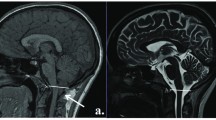Abstract
Introduction
While raised intracranial pressure (ICP) is a well recognized complication affecting children with syndromic craniosynostosis, certain percentage of the patients with non-syndromic craniosynostosis may have some problems related to increased ICP, such as developmental delay or visual problem. However, it is still not clear how many percent of and/or which types of craniosynostosis patients suffer from those symptoms, especially in older patients.
Objective
The aim of this study was to examine the ICP of older children with mild form of craniosynostosis to determine if any of them should be surgically treated.
Materials and methods
We measured ICP before making the decision for surgical intervention.
Results
Twenty-five of thirty-six patients had raised ICP in our series.
Discussion
All of the 25 patients were treated surgically and followed-up after more than 1 year. All patients improved in some degree. Further investigations should be performed to determine what is the threshold for raised ICP in children.
Similar content being viewed by others
References
Arnaud E, Renier D, Marchac D (1995) Prognosis for mental function in scaphocephaly. J Neurosurg 83:476–479
Becker DB, Petersen JD, Kane AA, Cradock MM, Pilgram TK, Marsh JL (2005) Speech, cognitive, and behavioral outcomes in nonsyndromic craniosynostosis. Plast Reconstr Surg 116:400–407
Bottero L, Lajeunie E, Arnaud E, Marchac D, Renier D (1998) Functional outcome after surgery for trigonocephaly. Plast Reconstr Surg 102:952–958 (discussion 959–960)
Connolly JP, Gruss J, Seto ML, Whelan MF, Ellenbogen R, Weiss A, Buchman SR, Cunningham ML (2004) Progressive postnatal craniosynostosis and increased intracranial pressure. Plast Reconstr Surg 113:1313–1323
Eide PK, Helseth E, Due-Tonnessen B, Lundar T (2001) Changes in intracranial pressure after calvarial expansion surgery in children with slit ventricle syndrome. Pediatr Neurosurg 35:195–204
Gambardella G, Zaccone C, Cardia E, Tomasello F (1993) Intracranial pressure monitoring in children: comparison of external ventricular device with the fiberoptic system. Childs Nerv Syst 9:470–473
Gripp KW, McDonald-McGinn DM, Gaudenz K, Whitaker LA, Bartlett SP, Glat PM, Cassileth LB, Mayro R, Zackai EH, Muenke M (1998) Identification of a genetic cause for isolated unilateral coronal synostosis: a unique mutation in the fibroblast growth factor receptor 3. J Pediatr 132:714–716
Kapp-Simon KA (1998) Mental development and learning disorders in children with single suture craniosynostosis. Cleft Palate Craniofac J 35:197–203
Minns RA (1984) Intracranial pressure monitoring. Arch Dis Child 59:486–488
Pople IK, Muhlbauer MS, Sanford RA, Kirk E (1995) Results and complications of intracranial pressure monitoring in 303 children. Pediatr Neurosurg 23:64–67
Renier D, El-Ghouzzi V, Bonaventure J, Le Merrer M, Lajeunie E (2000) Fibroblast growth factor receptor 3 mutation in nonsyndromic coronal synostosis: clinical spectrum, prevalence, and surgical outcome. J Neurosurg 92:631–636
Renier D, Sainte-Rose C, Marchac D. and Hirsch.JF (1982) Intracranial pressure in craniosynostosis. J Neurosurg 57:370–377
Sidoti EJ Jr, Marsh JL, Marty-Grames L, Noetzel MJ (1996) Long-term studies of metopic synostosis: frequency of cognitive impairment and behavioral disturbances. Plast Reconstr Surg 97:276–281
Shimoji T, Shimabukuro S, Sugama S, Ochiai Y (2002) Mild trigonocephaly with clinical symptoms:analysis of surgical results in 65 patients. Childs Nerv Syst 18: 215–224
Speltz ML, Kapp-Simon KA, Cunningham M, Marsh J, Dawson G (2004) Single-suture craniosynostosis: a review of neurobehavioral research and theory. J Pediatr Psychol 29:651–668
Virchow,R (1851) Uever den Cretinismus, namentlich in Franken, und uer pathologische Schadelformen. Verh Phys Med Ges Wurzburg 2:230
Author information
Authors and Affiliations
Corresponding author
Rights and permissions
About this article
Cite this article
Inagaki, T., Kyutoku, S., Seno, T. et al. The intracranial pressure of the patients with mild form of craniosynostosis. Childs Nerv Syst 23, 1455–1459 (2007). https://doi.org/10.1007/s00381-007-0436-0
Received:
Published:
Issue Date:
DOI: https://doi.org/10.1007/s00381-007-0436-0




